
Quassia is a plant genus in the family Simaroubaceae. Its size is disputed; some botanists treat it as consisting of only one species, Quassia amara from tropical South America, while others treat it in a wide circumscription as a pantropical genus containing up to 40 species of trees and shrubs.

Knightia is a small genus of the family Proteaceae endemic to New Zealand, named in honor of Thomas Andrew Knight. One extant species, K. excelsa (rewarewa) is found in New Zealand. Two further Knightia species are found in New Caledonia, although they were placed in the genus Eucarpha by Lawrie Johnson and Barbara Briggs in their influential 1975 monograph "On the Proteaceae: the evolution and classification of a southern family", a placement supported in a 2006 classification of the Proteaceae. A fossil species from upper Miocene deposits in Kaikorai has been described as Knightia oblonga. Knightia has been placed in the tribe Roupaleae of the subfamily Grevilleoideae.
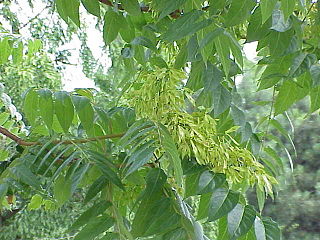
The Simaroubaceae are a small, mostly tropical, family in the order Sapindales. In recent decades, it has been subject to much taxonomic debate, with several small families being split off. A molecular phylogeny of the family was published in 2007, greatly clarifying relationships within the family. Together with chemical characteristics such as the occurrence of petroselinic acid in Picrasma, in contrast to other members of the family such as Ailanthus, this indicates the existence of a subgroup in the family with Picrasma, Holacantha, and Castela.
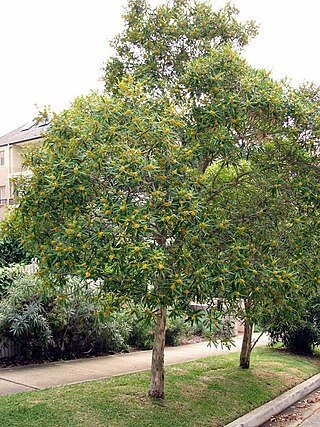
Tristaniopsis is a group of shrub and tree in the myrtle family Myrtaceae described as a genus in 1863. They have a wide distribution in Southeast Asia, New Guinea, New Caledonia and Australia.
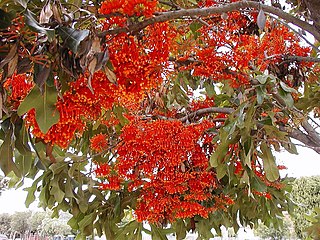
Stenocarpus is a genus of about 22 species of flowering plants in the family Proteaceae. They are trees or shrubs with variably-shaped leaves, zygomorphic, bisexual flowers, the floral tube opening on the lower side before separating into four parts, followed by fruit that is usually a narrow oblong or cylindrical follicle.
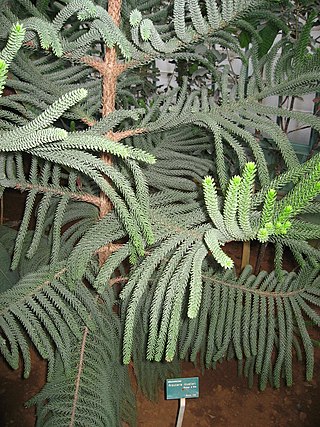
Araucaria muelleri is a species of conifer in the family Araucariaceae. It is a medium size tree, 10–25 meters in height, with larger leaves than most other New Caledonian Araucarias. It is found only in New Caledonia, in several sites in the far south of Grande Terre, the main island.
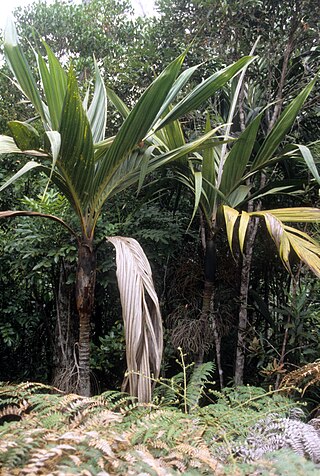
Basselinia is a genus of flowering plant in the family Arecaceae. The entire genus is endemic to the Island of New Caledonia in the Pacific. In some molecular phylogenetic analyses, Hedyscepe from Lord Howe Island is nested in Basselinia.
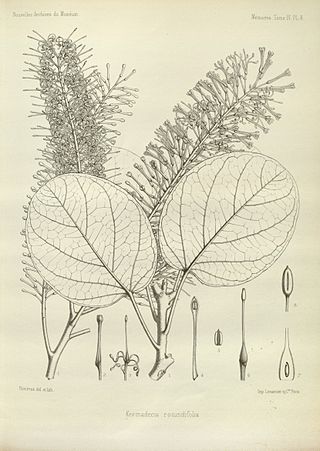
Kermadecia is a genus of flowering plants in the family Proteaceae. The genus comprises eight species of rainforest trees from New Caledonia, Fiji, and Vanuatu. Its closest relative is Euplassa from South America.

Pancheria is a genus of shrubs and trees in the family Cunoniaceae. It is to endemic to New Caledonia and contains 27 species. Leaves or whorled, simple or pinnate. The flowers are arranged in capitula, fruits are follicular. The species are dioecious. The genus is well diversified on ultramafic rocks and some species are nickel hyperaccumulators. It is related to Cunonia and Pterophylla. It was named after Jean Armand Isidore Pancher.
Soulamea terminalioides is a species of plant in the Simaroubaceae family. It is endemic to Seychelles.

Xanthostemon is a genus of plants in the myrtle family Myrtaceae, first described in 1857 by the German–born Australian botanist Ferdinand von Mueller. The genus is distributed across Malesia, Papuasia and northern Australia. The genera Pleurocalyptus and Purpureostemon from New Caledonia are morphologically close to Xanthostemon.

Joinvillea is a flowering plants genus in the family Joinvilleaceae. The family consists of one genus with species distributed from the Malay Peninsula to the Caroline Islands and high islands in the Pacific Ocean. It is evolutionarily significant as a relictual group that is a close relative of grasses. They closely resemble large grass plants, in both general appearance and microanatomy, but possess fleshy fruits.
Eucarpha is a genus of flowering plant of the family Proteaceae, endemic to New Caledonia. Two species are recognised. Up to 1975, these were classified within the genus Knightia until Lawrence Johnson and Barbara G. Briggs recognised their distinctness, particularly their prominent bracts, in their 1975 monograph "On the Proteaceae: the evolution and classification of a southern family". Nomenclatural combinations for these two species in the genus Eucarpha were published in 2022.

Cossinia is a genus of four species of rainforest trees, constituting part of the plant family Sapindaceae. The genus has a disjunct distribution, occurring in Mascarene Islands, Australia, New Caledonia and Fiji.
Dubouzetia is a genus of about eleven species known to science, growing from shrubs up to large trees, in Papuasia and Australasia and constituting part of the plant family Elaeocarpaceae.
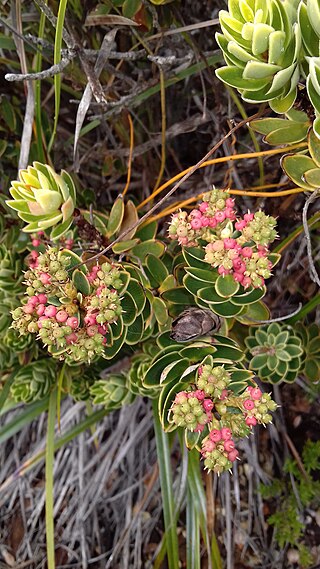
Cyathopsis is a genus of shrubs in the family Ericaceae. The genus is endemic to New Caledonia in the Pacific and contains three species that have previously been included in Styphelia. It is related to genera such as Leucopogon, Lissanthe and Styphelia.

Pterophylla is a genus of trees of the family Cunoniaceae, with species found growing naturally in Madagascar, Malesia, Papuasia, and the Pacific Islands, formerly included in Weinmannia.

Dracophyllum ramosum is a species of shrub or small tree in the family Ericaceae and is endemic to New Caledonia. It was first described by Adolphe-Théodore Brongniart and Jean Antoine Arthur Gris in 1864 and gets the specific epithet ramosum for the fact that many of its branches grow from the same place. It inhabits the summits and slopes of mountains, alongside streams, and on plateaux; it reaches a height of 0.5–5 m.

Cyathopsis albicans is a species of plant in the family Ericaceae, endemic to New Caledonia. It was first described as Leucopogon albicans in 1864 by Adolphe-Théodore Brongniart and Jean Antoine Arthur Gris, and transferred to Cyathopsis in 2005 by Christopher John Quinn.
















